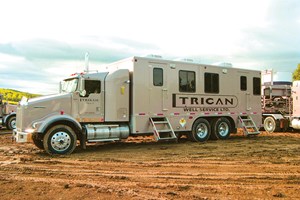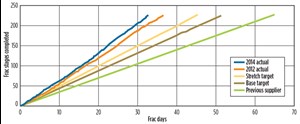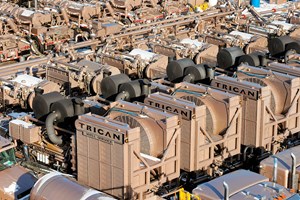Fracturing efficiency gains in Horn River basin prove value for Nexen

A recent hydraulic fracturing job in Canada’s Horn River basin demonstrates how natural gas producers—and their service companies—can innovate to reduce costs and improve efficiency in a “low price environment,” says Lyndsey Thomas, an enginner with Nexen, a wholly owned subsidiary of CNOOC Ltd.
Thomas points to 91% pumping efficiency, a record in that region, achieved by Trican Well Service of Calgary, Alberta, as evidence that with innovation, even higher rates—and much lower project costs—are possible. “Being able to improve beyond 91% efficiency is definitely something we are focused on for the future,” she said. “100% efficiency sounds pretty crazy, but with a lot of interesting ideas from our service providers, who knows?”
Thomas is a completions engineer for Dilly Creek field in northeastern British Columbia, Canada, Fig. 1. She supervised the hydraulic fracturing of a 10-well pad, and Trican was the principal contractor. Two years ago, Trican raised pumping efficiency to 86%, at the upper end of the industry standard for that area; the goal for 2014 was to do even better, Fig. 2.
“There’s a huge push to reduce spending,” she said. “We’re in a low-price environment, which requires fostering new ideas, new technology.”
The push to innovate is so strong within the industry that many fracturing projects are now priced using Key Performance Indicators—e.g., time spent pumping vs. time on location, time to rig in—and performance incentives. “On big jobs like this, the contracts are based on efficiencies,” said Scott Churchill of Trican. “You’ll have X amount for standard pumping efficiencies, and incentive targets for higher efficiencies.”
How big was the saving on the Horn River project? Trican fracturing specialist Paul Uhrich estimates it at tens of millions of dollars on the total scope of the project. Those are pretty big numbers, he says, and Trican is now using the same techniques on other fields within the Horn River basin.
CONTINGENCY PLANNING
The innovations for the Horn River frac were about doing things smarter and better. When crews are working in remote areas, as much as 12 hr away from their home base, planning for every eventuality is imperative, which is why preparations begin a year ahead of the project start date. “We start logistical planning months and months before, so when we get there, it’s all about execution,” says Churchill.

A seemingly simple task, like designing the location, takes on added importance, when the most efficient execution possible is the goal. How should the equipment be spaced? Is there room for a lay-down yard in case a spare unit needs to be swapped out? What about quick access to the spare chemical van or data van, Fig. 3? Each question must be carefully considered and planned.
Old-school ideas about lease design—a “rough idea” of where equipment should go and how work process should flow—don’t cut it on a high-volume, around-the-clock operation like Horn River. Trican uses software to help design leases, then site supervisors provide input to design iterations, as do Nexen and other suppliers. “Once it comes to execution time, it makes a world of difference when you have a practically laid out lease, where everybody’s worked through the design together,” said Churchill.
“Logistics on a project of this size are huge. We had a crew on site just to manage delivery and scheduling, making sure we had what we needed, when we needed it,” added Uhrich.
Uhrich estimates that the frac used 570,000 m3 (150 million gallons) of water and 44,000 tonnes (97 million pounds) of sand, which required 38 B-train loads to be delivered on-site every day.
Todd Marshall, Nexen’s on-site frac supervisor, agrees that properly organizing the project was a big part of achieving the 91% pumping efficiency. “Time waiting on stuff to arrive on location, to repair or maintain equipment—that wasn’t really an issue,” he said.
While Trican’s procedural and organizational practices are finding their way into fields within the Horn River basin, Uhrich expects that they will, eventually, be adopted into other North American plays that support multi-well pads and economies of scale. “Maybe not the Bakken, just because of the low pumping rate, but the Eagle Ford in South Texas or any of the American higher-rate fracs would benefit,” he said.
PUMP DOWNTIME
One of the biggest challenges facing the Nexen fracturing project was minimizing pump downtime. Feed water enters the fluid end at 80 psi and exits at up to 10,000 psi. In the event of a pump failure, the truck would normally be swapped out and sent back to the shop for repair. However, an alternative plan was devised for this project.
“We had a mechanic on location and a dedicated maintenance area. Our field guys used a picker truck to remove the damaged fluid end of the pump, then the mechanic replaced the internals, and in eight to 12 hours that truck was ready to go again,” said Churchill.
Between four and six pumps were kept on location, and extra pumps were rigged in to eliminate downtime, Fig. 4. If a pump went down, fracturing continued until the stage was finished, and then the affected pump was swapped out with a new one. In the past, the operation would have remained offline while pumps were repaired, perhaps for three to four hours.
Now, the time between fractures has been reduced to 10–15 min., said Uhrich. And when the cost-per-well pad ranges from $200/min. to $500/min., every minute counts.
A related issue was the erosion of blender tubs, where sand is mixed with the fracturing fluid before the resulting slurry is sent to the “fluid end,” pressurized, and pumped into the well. Churchill says carbon steel blender tub failures accounted for a significant amount of project downtime during the first year of the project. The problem was resolved by changing the blender tub to an exotic material, which was also used for a discharge pipe flange failing, due to erosion.
“I believe the first year we had seven blender tub failures, and the second year only one or two,” he said. “At two hours apiece, those failures really added to our average downtimes.”
WATER CONSERVATION
The next challenge that Nexen and Trican will tackle in the Horn River is water use. Hydraulic fracturing projects currently use water from nearby rivers, according to Thomas, and more fracturing means more demand on a finite resource. Public and governmental concerns have pressured industry to come up with interesting ways to use less fresh water. One solution that Nexen and Trican are considering for the Horn River is the use of produced water from a deep formation (3,200 ft) named the Debolt. The challenge is high hydrogen sulfide, which makes the water dangerous to workers’ health and introduces a host of handling issues for crews.
“Because of the H2S content, the water has to be kept above the bubble point pressure in order to keep the gas within solution,” she said. “That’s something frac companies aren’t familiar with, because the water is usually supplied at low pressure.”
Finding the right equipment was also a challenge, as H2S is highly corrosive. As part of a pilot project for the Horn River, Nexen worked with Trican engineers to find the right metallurgy for couplings, pump internals and other equipment. The service company tested metallurgy and coatings for internal pump parts—valves, seats, springs—to determine the most cost-effective solution, which provides the best corrosion resistance.
“Getting the right combination of variables was tricky, because we were balancing longevity and cost,” said Churchill. “We finally got it just right, and the pumps lasted as long on sour water as they would have running fresh water. The three weeks of testing played a big part in the project’s success.”
Trican averaged 8% sour water (from 10% to 25% over two-thirds of the project) or about 43,000 m3 over the course of the fracturing job. The volume is significant because of the difficulty, and cost, of accessing fresh water in northeastern British Columbia. Provincial regulators require Nexen to pull the water from a river or stream over the course of five months and store it in specially prepared pits, which have to be built nearby, and this represents another cost to the project.
The Debolt formation, however, is only 3,200 ft deep, consisting of bioclastic limestone at its base. One well was drilled, and it delivered a rate of 3–4 m3, which proved to be the limiting factor on the volumes of sour water for the pilot project. Churchill says the next Horn River job will involve multiple wells.
Nexen’s Thomas isn’t sure that the company will ever be able to solely use produced water, but even a high percentage would be a major achievement. With current technology, 80% appears to be the upper limit, because fresh water is needed in the blender tubs, which are open to the atmosphere and, therefore, unable to use sour water. “Even if we can use 50% sour water, then we can stretch five months of collected water over two well pads, lowering costs and making the play more economic,” Churchill said.
BI-FUEL PILOT PROJECT
Another significant saving for Horn River fracturing will come from the use of bi-fuel capability to power the pumps. Nexen and Trican conducted a small pilot project in 2014, where conventional fracturing pumps were modified to use a combination of natural gas, produced on site, and diesel. The reduction in diesel consumption amounted to just under $500,000, and the use of natural gas over diesel also resulted in a reduction in GHG emissions.
The Nexen project started with a strong incentive to find a substitute for diesel: The nearest fuel depot was 250 km away. “With the amount of fuel we used every single day over the month of the project, transporting diesel was a huge cost,” said Churchill.
Trican has a fleet of 22 bi-fuel pumps, which were designed to start substituting natural gas, based on horsepower demand. Operators were able to use between 60% and 70% gas. The gas came from several wells that Nexen had already completed on location. Sweetening skids removed H2S and CO2 to protect the pumps from corrosion.
Churchill says that producers are increasingly interested in bi-fuel pumps, especially on longer-term projects, where source gas is available.
INNOVATION
Squeezing costs from the supply chain and operating processes requires attention to detail. Trican has its eye on a number of smaller areas, where efficiency can be improved, including:
- Increasing pumping rates. The limiting factor is wellhead component erosion, which Trican believes can be mitigated.
- Reducing the number of plugs, which have to be drilled out after the fracturing job, or eliminating them altogether.
- Optimizing perforation strategy.
Executing hydraulic fracturing of multi-well pads has started to resemble an assembly line, where multiple operations transition seamlessly between one another, according to Churchill, and Trican has identified significant efficiencies that can be gained through better logistics and water use, and these can be applied elsewhere. Going forward, the challenge will be the many small, incremental gains that, taken together, can still generate significant savings for customers.
Natural gas prices aren’t projected to rise anytime soon, which means costs have to be contained, or reduced, so that companies like Nexen maintain a healthy bottom line. ![]()




